A Complete Guide to Oregon’s Fort Stevens State Park
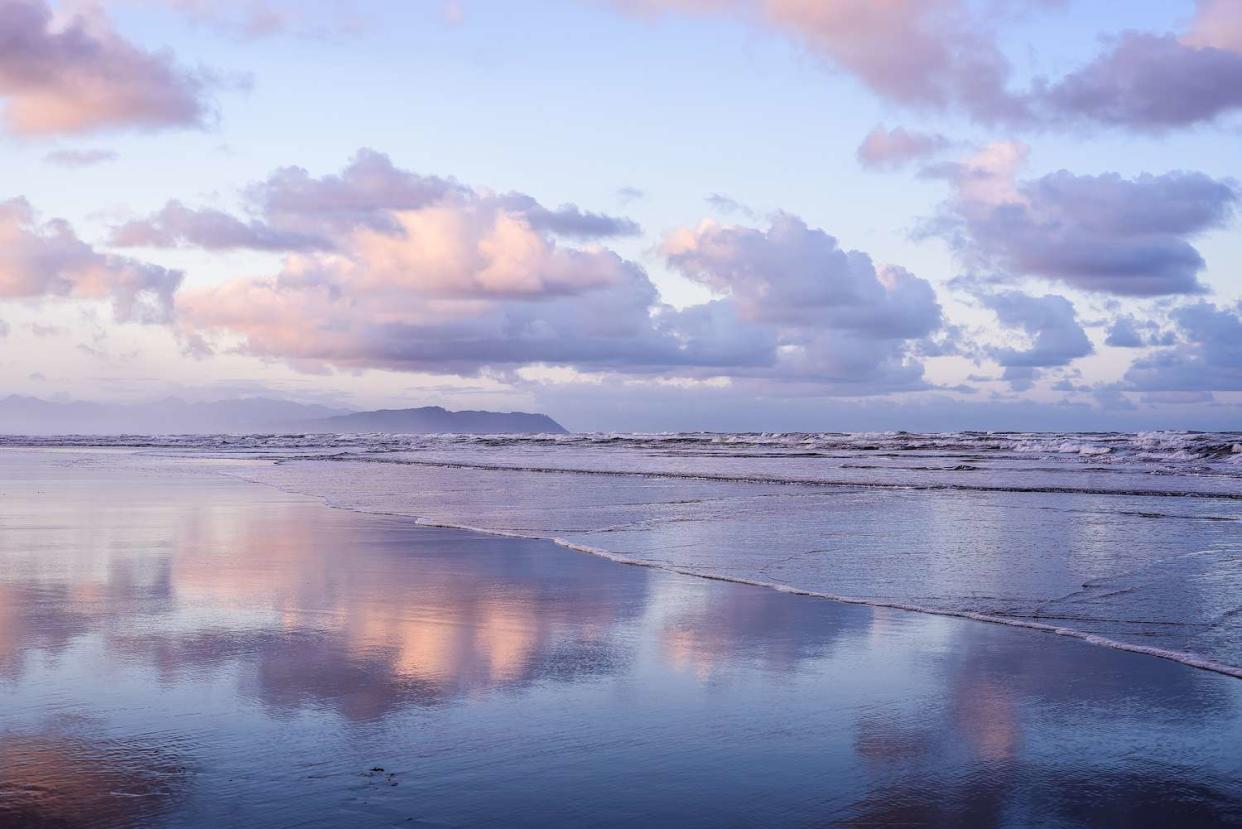
Robert L. Potts / Design Pics / Getty Images
You may not immediately recognize the name, but many travelers may recognize images of Fort Stevens State Park's most famous attraction: the wreck of the Peter Iredale. Shipwrecked on the Oregon coast in 1906, the shipping vessel is now no more than a steel skeleton, but it still attracts plenty of visitors (and photographers) eager for the chance to walk through a shipwreck.
But at 4,300 acres, the shipwreck isn’t the only thing to see and do in the coastal park. It’s home to one of the most in-demand beach campsites in Oregon and is a prime location for spotting gray whales from shore as they migrate south in early January and north in early April. It’s also where you’ll find one of Oregon’s biggest coastal campsites, and has more than two dozen historical buildings remaining from its days as a coastal line of defense during the Civil War and WWII.
Fort Stevens State Park is a highlight of the Oregon State Parks Department and a perfect place to stop on a road trip along the West Coast. Here’s what to know before planning your trip, including how to get campsite reservations and what to do while you’re there.
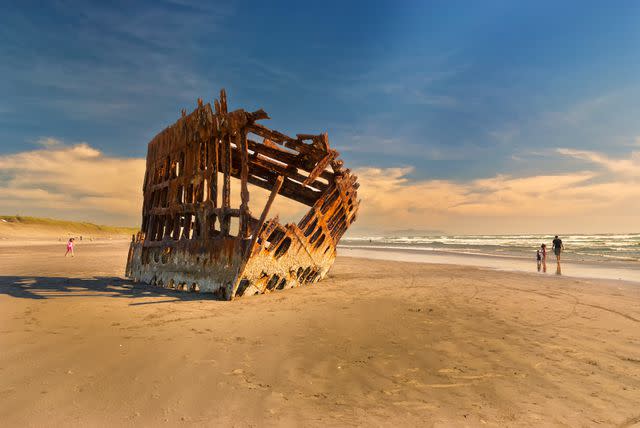
Sankar Raman / Getty Images
When to Go
Everything at Fort Stevens State Park is open year-round, including the campground and disc golf course. The most popular time for camping is from June into September when the daily high averages in the mid-60s.
In fact, the beachy location never gets very warm. You’ll have some days with sunshine and temperatures warm enough for lying on the beach, but it’s still the Pacific Northwest. Expect rain on any given day, and plan for partially overcast skies — though summer does tend to have the least rain.
Winter temperatures aren’t drastically different, with daily highs averaging around 50 degrees, but the chance of rain on any given day is higher. If you enjoy storm watching, visit between November and late March, when the waves and swells are at their annual peak.
How to Get There
Fort Stevens State Park sits on a peninsula in northern Oregon, at the mouth of the Columbia River. It’s about an hour and 45 minutes northwest of Portland, so it’s day trippable if you’re visiting the hip PNW city.
However, because of its beautiful seaside location, it’s most popular as an overnight stopping point for people road-tripping along the 101, California’s gorgeous coastal highway. The park is roughly 8 hours north of Crescent City, CA, making it an excellent stopping point for people road-tripping from California to Olympic National Park.
There’s no convenient public transportation in or around the park, and rideshare from Portland will likely be at least $200. You’re better off renting a car for a few days than trying to get there via other means. If you’re staying in nearby Astoria, a rideshare will likely cost around $25.
History of Fort Stevens State Park
The park’s human history is right there in the name: It used to be a military fort. The still-standing fort was built in 1863 and is currently open for tours between 10 a.m. and 6 p.m. daily. There are also underground tours in the summer. The fort was designed to protect the U.S. if the British tried to invade from Canada during the Civil War, but it was never needed, and none of its guns were ever used. Several thousand men were stationed there during WWII, but save for one record of a Japanese sub firing off the coast, it didn’t see much action.
Because of its prime location at the mouth of the Columbia, the park site was almost certainly a settlement for the Indigenous Clatsop people, though there are no formal records to confirm that. Fort Stevens is also the end of the Lewis and Clark National Historic Trail, a 4,900-mile route that follows the trail of explorers Lewis, Clark, and their guide Sacagawea.
Today, the fort is managed by Friends of Old Fort Stevens, in partnership with Oregon Parks.
What to Do at Fort Stevens State Park
Truthfully, the most popular activity at Fort Stevens State Park is probably the least official: admiring the views. Whether you stroll for hours on the beach or just bring a beach blanket to watch the sunset, it’d be hard to agree that it wasn’t a truly gorgeous place. But it’s especially known for a few specific activities:
Hiking
The park’s longest trail is the 9-mile Fort Stevens, Jetty Loop, and Fort Steven Ridge Trail, usually just referred to as “the long trail.” It traverses most of the park and goes past many of the sames as the walking tour below. The trail is paved, so keep an eye out for cyclists.
One of the most well-known hikes in the park is the short walk to the Peter Iredale shipwreck. From the campgrounds, it’s at the end of the .2 mile Sunset Trail. If you’re walking there from the Visitors Center, it’s a longer walk. There are several ways to get there, but the prettiest (and longest) route is to take the 1.1-mile Trestle Bay Trail to the coast, then walk along the beach on the 1.9-mile Kestrel Dune Trail, which leads to the wreck. Note that the ship is partially submerged during high tide.
Foraging
The PNW is one of the most lush areas in the U.S., and the park’s damp conditions and moderate temperatures are a perfect growing environment for many kinds of mushrooms. Mushroom foraging is popular in the park—so much so, in fact, that the park produces a free guide to the most common species. Remember that while edible mushrooms can be delicious, eating the wrong mushroom can be deadly, so always be 100 percent certain you know what you’ve picked. Also note that while psilocybin (hallucinogenic) mushrooms do grow in the area, they’re illegal to pick.
Self-Guided History Tour
The building that now houses a museum is the most well-known historical building at the park, but it’s not the only one. The fort is a collection of 39 historical buildings and sites, from bunkhouses to a military hospital to a Native American longhouse. You can pick up a brochure when you arrive on-site or download the walking tour brochure in advance. Park directly in front of the Fort Stevens Museum if you’re planning to follow the route in order.
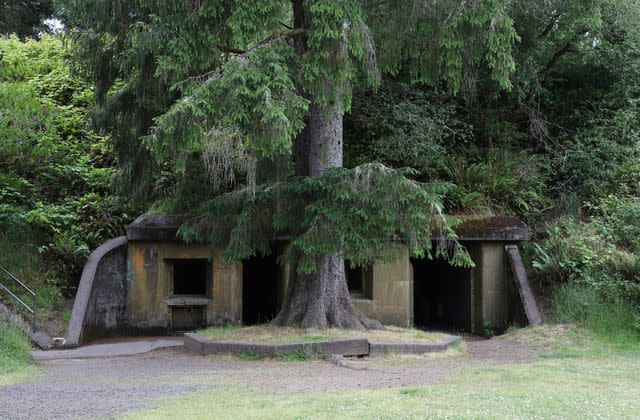
Nancy Strohm / Getty Images
Wildlife Watching
Wildlife at Fort Stevens State Park ranges from the humongous to the petite. With a little patience, you may be lucky enough to spot a gray whale from the shoreline near the Peter Iredale. Gray whales migrate in December through January, and April to late May, and you can occasionally spot humpbacks in August and September. Look at the horizon to spot their blowholes, as whales usually surface every 3-5 minutes while on the move. Oregon State Parks actually hosts “Whale Watching Week” events throughout the migration season.
If whales aren’t your thing, wake up early to go birding along the park’s shoreline. The park hosts free 9 a.m. guided bird walks and hikes several times a month. You can also B.Y.O. binoculars and go out on your own. E-Bird has an excellent app for identifying and tracking common and rare birds in the area.
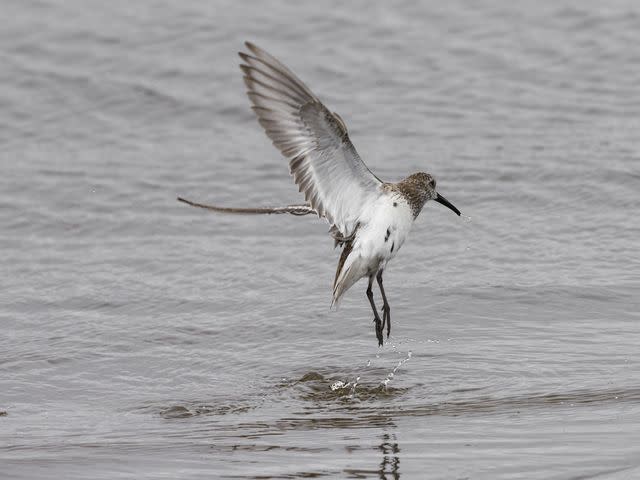
GarysFRP / Getty Images
Disc Golf
Disc Golf doesn’t require a lot of skill, but it’s a fun way to spend a few hours outdoors while introducing a little bit of fun competition. Fort Stevens State Park is where you’ll find the 23-basket Columbia Shores Disc Golf Course, and you can bring your own discs or buy them at the park store. There’s no cost to play, except for the $5 park entry fee.
Camping at Fort Stevens State Park
Fair warning about camping at Fort Stevens State Park: You’re likely to get spoiled if this is the first place you’ve camped along the Oregon coast. The actual sites are pleasant enough, with flat tent areas, grassy lawns, and picnic tables at each site, but the proximity to the ocean is what really sets the sites apart.
The campground is large, with 476 sites. Most are RV-friendly, and 174 of those have full hook-ups—the rest have water and electricity. The park also has six tent-only sites and nine “hike-in” sites. (Though, you can park about three minutes away.) Reservations aren’t required, but they are recommended and can be made up to six months in advance on ReserveAmerica.com. Because Fort Stevens is such a popular campground, it’s not unusual for it to fill up on prime summer weekends. Make reservations in advance if you’re able. Sites start at $35/night or $11/night for the hike-in spots.
If you prefer something a little more comfortable, make reservations for one of the park’s 11 cabins or 15 yurts. Cabins have decks, outdoor grills, and kitchenettes, and sleep between 5 to 8 people. Yurts have a bunk bed and futon, along with a small lounge area, but share bathrooms with the rest of the campground. Reservations are required for cabins (from $98/night) and yurts (from $54/night).
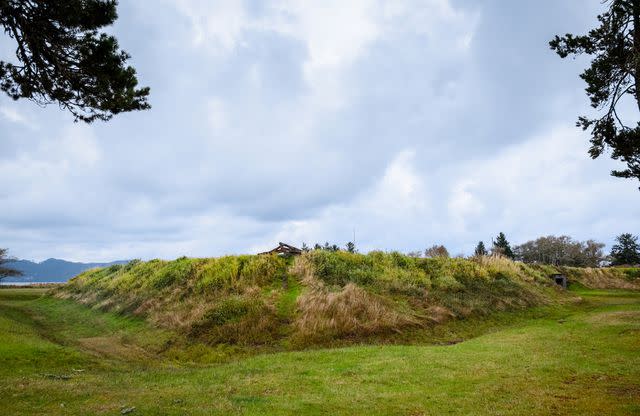
zrfphoto / Getty Images
Hotels Near Fort Stevens State Park
Fort Stevens State Park isn’t very urban, and most of the surrounding coastline is fairly undeveloped—or at least mostly residential. There’s not a lot in the park’s town of Hammond—save for the basic South Jetty Inn—so your best bet for a hotel near Fort Stevens State Park will be to stay in Astoria, which is just 9 miles from the park. It’s a pretty seaside town with Victorian architecture and strong maritime influences—and great seafood.
In Astoria, the Bowline Hotel is a great pick for blending modern style and history, especially as it's housed in a converted cannery building on the waterfront. Each room has a unique blend of vintage decor, and amenities include seaside barrel saunas and a hip on-site cocktail bar.
For something with a more romantic, luxurious feel, check out the Cannery Pier Hotel and Spa. It sits on the edge of a pier in the Columbia River, and rooms are large with perfect waterfront views. It’s pricier but includes perks like complimentary breakfasts, fresh-baked cookies in the afternoons, and taxi service in vintage cars.
There are also a few chain hotels, including a Motel 6 and Comfort Inn, if you prefer a more budget-friendly stay.
Dogs
Fort Stevens State Park is pretty dog-friendly, as are most Oregon parks. Dogs are allowed in the campsites, and half of the yurts and cabin rentals allow dogs for an extra $10 per night. Your furry friend can join you on all trails unless otherwise signed, and can even stroll along the beach with you, provided they’re on a leash.
Dogs can run off-leash at Oregon beaches outside of state parks. Occasionally, sections of the beach may be closed to dogs due to seabird nesting, but signs will be posted nearby if that’s the case. There’s a whole webpage just for pups at Oregon parks and beaches.
Accessibility
All campgrounds at Fort Stevens are ADA accessible, as are about half of the cabins and yurts. Most of the paths around the park are paved, and there are five parking areas (lots A, B, C, D, and one near the Peter Iredale) where you can park extremely close to the sand with no long walk to reach the beach. The entire museum complex is ADA-compliant, and interpreters at the welcome center can assist anyone with visual impairments or hearing impairments. Note that the wildlife viewing bunker on the Columbia River is accessed only via a one-story staircase.
Additional Tips
Swimming: You can swim anywhere you want at Fort Stevens State Park, but there are no lifeguards on duty or designated swimming areas. Remember that the water is usually fairly cold year-round, which can increase the risk of drowning. Be smart, never swim alone, and pay attention to surf reports or ocean warnings to make sure it’s safe to be in the water.
What to wear: Even if it’s warm and sunny, bring a jacket that offers wind and rain protection. It frequently rains year-round, and it’s the kind of place where you do need to pack for multiple seasons in a single day. Quick-drying clothing is helpful, and even in the summer, you may want an insulated jacket and beanie, especially if you’re walking along the shore.
Camping tips: Because the park’s climate is wet and sometimes rainy, you’ll want a tent footprint (like a tarp), rather than putting your tent directly on the ground. Consider bringing a tent with a vestibule and/or a pop-up canopy to create a dry area at your campsite.
Beach driving: You can drive on the beach during certain times of the year, with some restrictions. Review the rules in advance, and don’t try it unless you have a 4WD vehicle.
Bags: You can’t bring backpacks, purses, strollers, or any kind of selfie stick into the cave.
Cell service and Wi-Fi: Don’t count on either. Cell service is spotty and depends on your carrier. If you need to stay somewhere with Wi-Fi, book the Hammond Marina RV Park just across the street from the park entrance.
Park fees: Visiting Fort Stevens won’t break the bank: a day-use pass is $5 per car, which you pay on arrival.
Read the original article on TripSavvy.

